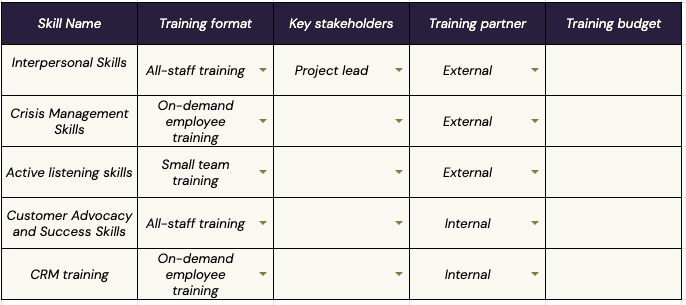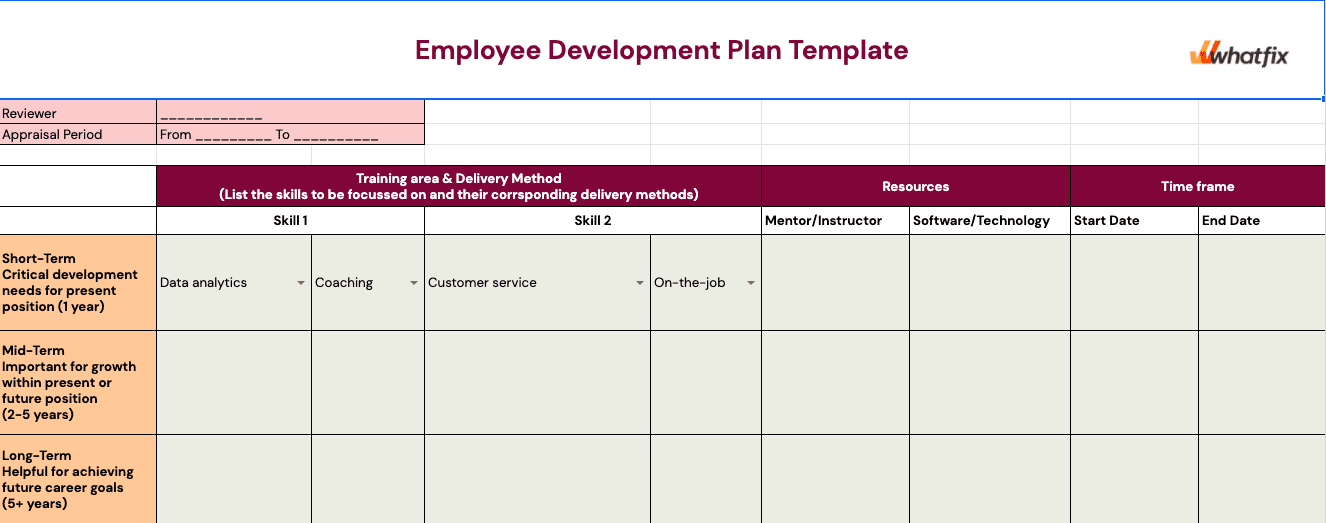
Organizations turn to corporate learning and development strategies to ensure that each employee is equipped with the right skills and knowledge to perform their job efficiently. Effective employee training programs are a highly successful and valuable practice for organizations to upskill, and reskill their workforce, adopt new technologies, and enter new markets.
Creating a training plan tailored to individual employee needs while still sticking to necessary, company-wide standards is the most efficient way to ensure every employee receives the training they need.
If your organization is looking to create one (or multiple) employee development plans or refresh the current training content, this article will guide you through the process of creating effective employee training plans.
What is an employee training plan?
At the most basic level, an employee training plan is a document that details a training program. It outlines the goals of training, learning outcomes, training methods, strategies, and curriculum to train employees across the organization.
What are the must-haves in an employee training plan templates?
An employee training plan clearly explains what must happen to meet the set training requirements. Here are some essential, must-haves of employee training plan templates.
- The objective of the training
- Type of training – online or face-to-face learning
- KPIs and other measurables to calculate the ROI
- Training timelines (start and end dates)
- Training method
- Training material
- The segment of employees who will attend the training
- The list of digital tools employees need to use
Why is an employee training plan important?
Employee training brings a wide range of benefits to a business, including
- Filling knowledge gaps: Regularly investigating your employees’ skills helps analyze skill gaps in knowledge and ensure they have the competencies required to do their jobs effectively.
- Enhancing employee performance: Employees who regularly undergo training learn new skills, update existing skills, and become more confident, efficient, and productive at their jobs.
- Improving employee retention: Conducting continuous training programs makes employees feel important and adequately prepared to do their jobs well, leading to higher job satisfaction, lower rates of absenteeism, and increased retention rates.
- Ensuring succession planning: Having a solid employee training plan ensures that you have someone ready to step into the role when a team member leaves.
- Maintaining consistency: A strong training plan ensures everyone is working from the same information base. Training every employee the same way promotes consistency throughout the team and ensures that the company’s policies and procedures are followed as expected.
4 types of employee training plan templates
Many organizations struggle to build a structured and efficient training process from scratch. To ease the process, companies can use prebuilt templates and checklists as a start to create scalable and productive training programs. Here are a few types of employee training templates.
1. New-hire training template
New hire training is essential to help new employees start on the right foot. This training plan is implemented for practical reasons such as providing insights into the job role, familiarizing with company policies and procedures, demonstrating enterprise tools, etc.
An effective new-hire training plan helps eliminate the new workplace jitters, uncertainty, and low morale that new hires might feel if they’re not adequately supported in their initial days. Templates created for new-employee training are utilized to ensure an organization’s success in these programs.
2. Training needs assessment template
Creating a training needs assessment plan before launching a training program lay the necessary groundwork to understand an organization’s actual need for specific training programs and make decisions based on measurable outcomes to achieve better ROI.

3. Individual employee training plan template
An employee training plan is a document that details a training program and outlines the goals, learning outcomes, training methods, strategies, and curriculum for training employees across the organization.
✓ Thank you, the template will be sent to your email
4. Employee development plan template
Employee development plans are proactive, forward-looking action plans for employees to acquire new skills and competencies. They’re driven by a set of goals that employees wish to achieve to improve their jobs and advance in their careers.

13 additional learning & development templates
We have gathered some of the most comprehensive and high-quality employee training templates and checklists to help you design a dynamic, scalable training process for your organization. These templates will help you identify and focus on key employee development areas.
Employee Training Policy Templates
Training Plan Templates
- Skills gap analysis template
- Training plan template
- Pre-training checklist
- 70-20-10 learning model template
- SMART goals template
Post Employee Training Templates
- Training effectiveness feedback form
- Post-training survey questions for your employees
- Training ROI calculator
Employee Training Plan Templates for Different Training Programs
6 tips for building an effective employee training plan
Here are a few tips for building an effective employee training plan.
1. Assess Training Needs
Conducting a training needs analysis is a crucial step of your employee training plan to develop effective training materials and make the best use of your production time.
A training needs assessment helps identify who needs to be trained, the gap in skills, and the type of training that will fill the training requirements. A needs assessment is conducted through research, interviews, internal surveys, observations, etc.
2. Set Training Goals and Objectives
An employee training plan contains the long and short-term measurable outcomes that employees are expected to achieve after completing a training program. These objectives communicate the tangible benefits of the training in a way that engages and resonates with employees.
When developing training objectives, make sure metrics give the whole picture, including quantity, quality, time, cost, and effectiveness and are aligned with overall business goals.
3. Determine Training Method
The next step in the employee training plan is to choose a suitable employee training method ideal for the overall organization and individual team members. To find the most appropriate employee training method for your training program it is crucial to understand the learning style of your employees.
Other important factors to consider for narrowing down the training method selection are – training objectives, goals, cost, timeline, organization’s culture, size, remote or office-based environment, etc.
For instance, smaller companies prefer in-person training programs more cost-effective, whereas larger enterprises or distributed companies benefit from online self-paced training that requires less coordination.
Some of the most common employee training methods are:
- eLearning
- On-the-Job Training
- Instructor-Led Learning
- Roleplaying
- Coaching
- Simulation Training
- Group Activities
- Video Training
- Cross-Training
- Job Shadowing
- Case Studies
4. Determine Training Technology
Investing in employee training software empowers HR teams and people managers to create and assign training courses to employees and monitor progress and track completion rates. These tools standardize the employee training procedure across the organization and use various interactive learning techniques to engage employees. Here are a few examples of training technology companies can invest in
- Corporate Learning Management Systems (LMS) – These systems provide progress tracking, course organization, and training management features to scale training and development across the company.
- Digital Adoption Platform (DAP) – DAPs are an employee training solution that provides automated, personalized training in the flow of work. DAPs assign each learner a contextual task list containing interactive walkthroughs and other in-app content based on the learner’s role or title. Walkthroughs are a series of step-by-step prompts that show users how to complete a certain process by guiding them through each step, showing them relevant training videos, or providing informative articles.
- Knowledge Management System – These systems provide an online, self-service center for employees to search for answers to any question on company policy, benefits, or processes. These knowledge base software tools act as internal wikis for companies.
- Video Training Software – These platforms allow HR teams and people managers to create video content for onboarding and training their team members.
5. Determine Training Budget
Your training budget is allocated for your L&D program’s implementation based on the training needs and training methods. This budget includes paying for the trainers and their travel expenses, setting aside a place for hosting a workshop or seminar, paying for the training software, and other additional resources such as paper, ink, print materials, extra educational programs.
6. Evaluate the Effectiveness of Training Plan
To understand whether or not your employee training plans are working, determine if the learning objectives are met at the end of the training. Consider the following methods to measure the effectiveness of your employee training plan:
- Collect post-training employee feedback via interviews or anonymous online surveys to determine whether the training plan helped employees learn new things or enhance their existing skillsets.
- Conduct tests or quizzes to evaluate learner knowledge post-training.
- Observe employees to figure out whether or not they’re using the new knowledge in their day-to-day tasks.
- The training software’s data analytics dashboard can be used to determine how employees are interacting with the training.
- After a month or a quarter, analyze your training results by determining whether the training corresponds with a rise in revenue, a decrease in costs, changes in employee productivity, etc.
Employee Training Plan
FAQs
What are the different employee training methods?
Some of the most common employee training methods are:
- eLearning
- On-the-Job Training
- Instructor-Led Learning
- Roleplaying
- Coaching
- Simulation Training
- Group Activities
- Video Training
- Cross-Training
- Job Shadowing
- Case Studies
What are the tips for building an effective employee training plan?
Here are a few tips for building an effective employee training plan:
- Assess Training Needs
- Set training goals and objectives
- Determine training method
- Determine training technology
- Determine training budget
- Evaluate the effectiveness of training plan
These were the basics of an employee training plan; the rest of the details are up to you! Using the information and templates mentioned above, you’ll be able to easily fill out the training process and create the perfect employee training plan that fits your organization’s requirements.
However, to truly maximize your training—we recommend implementing a Digital Adoption Platform. A digital adoption platform enables learning via interactive walkthroughs, videos, and self-help menus and allows you to train employees on-demand while providing insights to measure training effectiveness. Whatfix DAP enables you to create scalable employee training flows built directly into your website or enterprise applications – allowing employees to learn in the flow of work.
Request a demo to see how Whatfix empowers organizations to improve end-user adoption and provide on-demand customer support
Thank you for subscribing!



